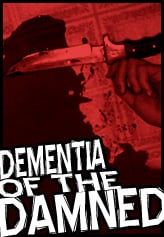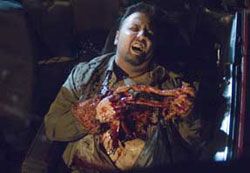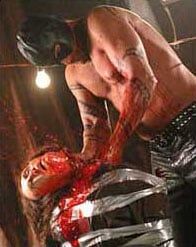Dementia Of The Damned #3

Welcome back to the Dementia of the Damned, Cinema Blend's monthly look at the state of horror. This month, I cleared my schedule and took in two seasons of the "Masters of Horror" to determine if Showtime's original series delivers the goods it promises.
Like a band of darkly-robed humanoids looming over a boiling caldron, carefully preparing the rites for a bloody sacrificial ceremony, horror film fans are a ravenous cult. They scour theaters and video stores eager to find the next big chill and thrill – new or old. In this hunt for blood, leading genre director emerge from the corpses of discarded videotapes that promised scares, but didn’t deliver. Some of these names, like John Carpenter, have heard by all because, let’s face it, everyone likes a good scare every now and again. Then there are the directors that make horror fans salivate at the prospect of fresh meat from their favorite butchers. Filmmakers such as Dario Argento (Suspiria, Deep Red), Takashi Miike (Audition, Ichi the Killer, Stuart Gordon (Re-Animator) and Tobe Hooper (Texas Chainsaw Massacre), who all hopped on board with the “Masters of Horror” – Showtime’s TV series that gives horror directors free reign.
Reminiscent of HBO’s “Tales from the Crypt” (minus the Crypt Keeper, who is sorely missed), “Masters of Horror” episodes boil down to an hour-long morality tale, complete with blood, guts and tits. Although the show barely offers anything to anyone outside the horror film occult, “Masters of Horror” is an expansive look at the genre as a whole – from the exploitive gore to the extremely boring.
Masters of Horror, Indeed
Initiation into the Occult O’Horror takes place at a very young age, with gateway (to hell) movies -- staple horror viewing of John Carpenter, Alfred Hitchcock, George Romero and Tobe Hooper, even Steven Spielberg’s Jaws spills into this category as a modern classic monster movie. Once we get our first taste of cinematic blood, we want more films that challenge our need for sleep. That’s when the search begins. Hunting through the obscure, we quickly find that there’s no such thing as “foreign” when it comes to terror; fear is universal. That leads us to the likes of Italian maestros Dario Argento and Lucio Fulci and Japanese mood-masters Kiyoshi Kurosawa and Takashi Miike. Their pension for blood and ability to manifest tension earns them a pedestal in the chamber of horror deities.
“Masters of Horror” takes us on a similar journey. It covers the old-school, the new school and the directors who never went to school. The implicate meaning of the word “Master” is that these are auteur directors. Basically, an “auteur” is just a fancy French term for a director who controls all aspects of his work and the film reflects that director’s personal style. David Lynch is a prime example of an auteur, as you always know when you are watching a David Lynch movie.
The problem for “Masters of Horror” is that, despite a director’s ability to create an amazing horror film, it doesn’t make him an auteur. Tobe Hooper’s Dance of the Dead, for example, emulates MTV with its jarring jump cuts and saturated stylization. We don’t admire Hooper for his cutting-edge style. We still tremble in Texas Chainsaw Massacre’s presence because of Hooper’s ability to bring a seemingly over-the-top situation down to Earth and how he fills his scenes with a sense of immediacy. While Hooper succeeded (on some level) in creating a realistic post-apocalyptic world, his directorial body of work as a whole doesn’t encompass a unified vision, thus his techniques are unrefined and shaky at best.
CINEMABLEND NEWSLETTER
Your Daily Blend of Entertainment News

On the other hand, the show is a saving grace for Dario Argento, an auteur who delivers with Pelts. Combining his fascination with the supernatural and his ability to spill blood like none other (not to mention, fetish for creepy children’s music), Argento crafts a story about a fur peddler played by Meatloaf (that’s right, “Bat Out of Hell’s” Meatloaf) who discovers perfect raccoon pelts, which entrances anyone it comes into contact with and forces them to mutilate themselves, all while he pines over a stripper. Playing the genre for everything it’s worth, Argento sandwiches mutilations such as a man doing a face plant into a bear trap and Meatloaf cutting his skin and taking it off like a t-shirt in between lap dances. After the abysmal Card Player and Phantom of the Opera, Pelts shines a ray of hope on Argento’s upcoming theatrical film, The Third Mother.
The same can be said for John Carpenter. Though his recent credits only consist of (cringe) the Ghosts of Mars and Escape from L.A., Carpenter gives his best effort since 1988’s They Live. Cigarette Burns is an overly-preachy story about a theater owner who tracks down rare films and is contracted by Udo Kier to find a film print of Le Fin Absolue du Monde -- a film so disturbing that it turns its audience into murderers. In 50 minutes, Carpenter captures the horror genre rumor mill fuels our search for horror. The way people talk about films builds them into something greater than they are. It creates an air of intrigue and forbidden uncertainty that excites us.

Unfortunately, Carpenter covers his strengths with an attack on Hollywood and endless references to other films. From Deep Red to the French New Wave, Carpenter seems to be more concerned with winking at the audience through his dialogue. That is, until he gives us a full on-screen decapitation without a cut. It’s executed with unflinching brutality and stability that is shocking coming from Carpenter, and it snaps us out of our complacency. To top it off, Udo Kier feeds his guts into a film projector in an effort to “make his own film” – endlessly pretentious and masturbatory, but Udo pulls it off.
A Horrific Imprint
Leave it to a show that idolizes horror directors just as much as their fans to not be outdone by its own material. Like the unmentionable film in Cigarette Burns, there is an episode under the “Masters of Horror” banner that you are not supposed to see. A film so shocking that it churns audiences’ stomachs and turns even the most seasoned, desensitized horror fan into a cringing, contorted eye-shutter. A film that was commissioned by “Masters of Horror,” and then it was quickly disavowed by Showtime at first sight. Yes, the elusive Imprint from Takashi Miike earns its infamy by crossing more lines than it should.
There are images that mill about in horror cultists’ memories, only to make an appearance in the quiet moments before we peacefully fall asleep. The first remembered image of Michael Meyer’s face, a knife plunging into a heart in Suspiria and now, courtesy of Miike, an aborted fetus falling out of a basket like a bushel of apples, only to be picked up by a child and discarded in a river moments later. Sure, the story of a tortured prostitute in ancient Japan is wrought with torture and violence, but it’s the flashbacks of village abortions that move your thumb toward the remote’s “stop” button.
It’s no wonder why Showtime didn’t air this episode; in fact, it’s amazing that it received a “Masters of Horror” DVD release. Nevertheless, it accomplishes the goal of “Masters of Horror” more than any single episode. The aim of the series is to give worthwhile directors an open palette to explore the horror they create. In a sense, Miike delivers on all aspects by topping many of his own extremes and capitalizing on his steady director’s hand.

Politics aside, no one is going to enjoy watching graphic abortions. The act itself is dealt with in such a distant matter that it’s almost sub-human. The abortion images polarizes any admiration for Miike’s earlier patient torture scene. Yet, the abortions never feel too gimmicky, but perhaps the sheer shock prevents any objectivity. It was merely the prostitute’s mother’s occupation – village abortionist. Of course, then Miike adds a dash of incest and a talking mutation at the end, which only solidifies the head-shaking disbelief. These are lines that are usually crossed only in pseudo-snuff films (also known as guinea-horror), the likes of Cannibal Holocaust, not a cable TV show.
Horror Obscura
What we can’t see or shouldn’t see is what drives us through the ranks of the Occult O’Horror. Yet, in creating a mountain out of a hell hole, we mystify films to the point where they could never live up to our expectations. Perhaps that is why the “Masters of Horror” is a perfect ideal. What could be better than offering overshadowed directors, like Stuart Gordon, John Landis and Joe Dante, another stab at the horror palette? Unfortunately, the demands for blood are not easily met.
Both Landis, of American Werewolf in London fame, and Dante, the genius who brought us The ‘Burbs, miss their comedic horror marks. Landis’ Family has a few moments that shine through the boredom, including watching George Wendt chemically melt the skin off his victims and hearing Andie from “Dawson’s Creek” tell Norm from “Cheers” how she’d like to suck him off. Oddly hilarious moments such as these are missing from Dante’s preachy Homecoming, a politically-fueled rant against the Iraq War. Zombies that come back to life to vote instead of devour brains? No thanks, even Romero isn’t that far off his rocker.

Gordon, on the other hand, has a fighting chance with his adaptation of H.P. Lovecraft’s Dreams in the Witches House. Like most Lovecraft works, there is a dash of science fiction in this “Masters of Horror” episode. Though Gordon has delved into Lovecraft’s world before with Re-Animator, he still trivializes Lovecraft’s work, reducing it to a series of plot devices rather than an exploration of scientific possibilities. Then again, this an hour-long show, and Gordon still offers his fair share of violence, nudity and a human-faced rat.
By giving old hands a fresh start and shedding light on directors who usually don’t get much exposure, the idea of “Masters of Horror” is more exciting than the sum of its episodes. Though it’s easy to get swept up in the possibility of your favorite old-school horror director making a small-screen come back, “Masters of Horror” is best enjoyed as an hour with your cult favorites; to kick back with an empty horror quickie, as you contemplate which director “Masters of Horror” might resurrect.
This Month’s Horror Picks
In Theaters
Bug (Friedkin, 2006) *Note: Bug isn’t exactly horror, but it definitely has some horrific moments, and it’s an amazing film.*
On DVD (Masters of Horror)
Pelts (Argento)
Cigarette Burns (Carpenter)
Imprint (Miike)
Dreams in the Witch’s House (Gordon)
Next Month’s Dementia of the Damned: Attack of the 1950’s B-Movie .
Read previous editions of Dementia of the Damned by clicking here.
Most Popular



